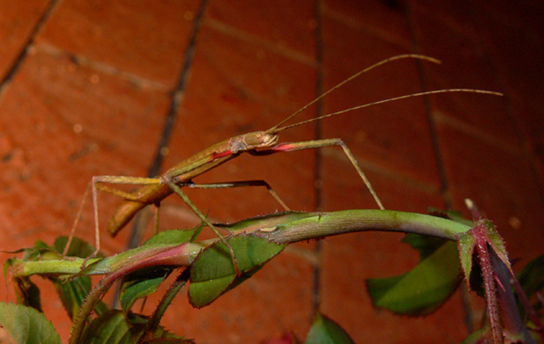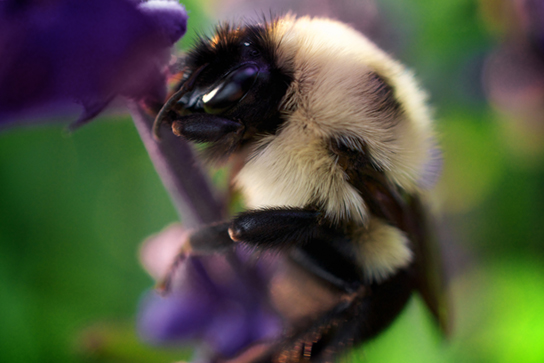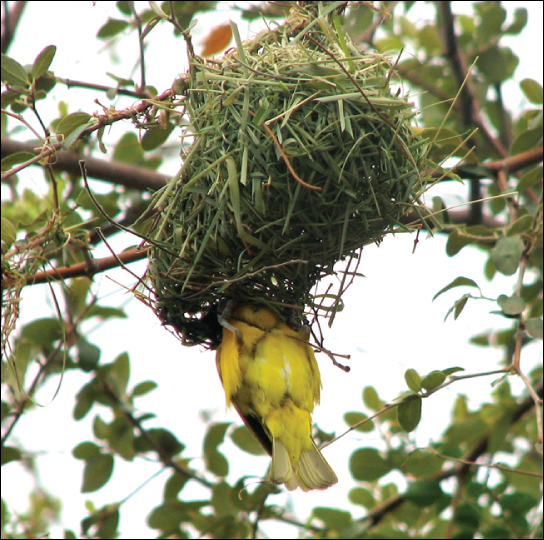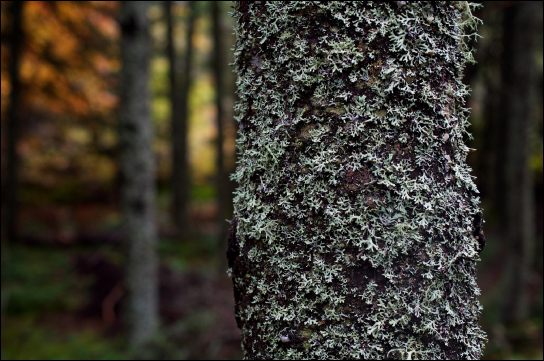45.6: 社区生态学
- Page ID
- 202989
培养技能
- 讨论捕食者-猎物的循环
- 举例说明对捕食和草食象牙的防御
- 描述竞争排斥原则
- 举例说明物种之间的共生关系
- 描述社区结构和继承
种群很少与其他物种的种群隔离生活。 在大多数情况下,许多物种共享一个栖息地。 这些种群之间的相互作用在调节种群增长和丰度方面起着重要作用。 居住在同一栖息地的所有种群组成一个群落:人口同时居住在特定区域。 占据相同栖息地的物种数量及其相对丰度被称为物种多样性。 多样性低的地区,例如南极冰川,仍然有各种各样的生物,而热带雨林的多样性如此之大,无法计算。 在社区层面研究生态学,以了解物种如何相互作用并争夺相同的资源。
捕食与草药象牙
也许物种相互作用的典型例子是捕食:捕食者猎杀猎物。 电视上的自然节目重点介绍了一个活生物体杀死另一个生物体的戏剧。 一个群落中捕食者和猎物的数量不会随着时间的推移而保持不变:在大多数情况下,它们的周期各不相同,似乎相互关联。 最常被引用的捕食者-猎物动态的例子是山猫(捕食者)和雪鞋野兔(猎物)的循环,使用来自北美森林的近 200 年前的诱捕数据(图\(\PageIndex{1}\))。 捕食者和猎物的这种周期持续约10年,捕食者的数量比猎物种群落后1-2年。 随着野兔数量的增加,有更多的食物可供山猫使用,这也使山猫的数量也有所增加。 但是,当山猫数量增长到阈值水平时,它们会杀死如此多的野兔,以至于野兔数量开始减少,随后由于食物短缺,山猫数量减少。 当山猫数量较少时,野兔种群规模开始增加,至少部分原因是捕食压力低,从而重新开始了这个周期。

这两个物种的种群循环完全由捕食模型控制的想法受到了质疑。 最近的研究表明,除了捕食之外,未定义的密度依赖因素在循环中也很重要。 一种可能性是,这种循环是野兔种群固有的,这是由于密度依赖性效应,例如野兔种群变得过于密集时拥挤导致生殖力降低(母体压力)。 然后,骑野兔会诱发山猫的循环,因为它是山猫的主要食物来源。 我们对社区的研究越多,我们发现的复杂性就越大,这使生态学家能够得出更准确、更复杂的人口动态模型。
Herbivory 描述了昆虫和其他动物对植物的消耗,这是影响种群的另一种种间关系。 与动物不同,大多数植物无法超越捕食者,也无法使用模仿来躲避饥饿的动物。 一些植物已经开发出抵御草药象牙的机制。 其他物种已经形成了互惠关系;例如,草药象牙提供了一种有助于植物繁殖的种子分配机制。
对抗捕食和草药象牙的防御机制
对社区的研究必须考虑作用于其中所含不同种群成员的进化力量。 物种不是一成不变的,而是通过自然选择和其他进化力量缓慢变化和适应环境。 物种已经进化出许多逃避捕食和草药象牙的机制。 这些防御措施可能是机械的、化学的、物理的或行为的。
机械防御,例如植物上有荆棘或海龟身上有硬壳,会对捕食者造成身体痛苦或物理阻止捕食者吃掉猎物,从而阻止动物捕食和草食象牙。 化学防御由许多动物和植物产生,例如毛地黄,食用后毒性极强。 \(\PageIndex{2}\)该图显示了一些生物对捕食和草药象牙的防御能力。

许多物种利用其体型和颜色来避免被捕食者发现。 热带拐杖是一种具有树枝颜色和体型的昆虫,在真正的树枝背景下静止时很难看见(图\(\PageIndex{3}\) a)。 在另一个例子中,变色龙可以改变其颜色以匹配周围环境(图\(\PageIndex{3}\) b)。 这两个都是伪装的例子,或者通过与背景混合来避免被发现。


有些物种使用着色来警告捕食者它们不好吃。 例如,朱砂蛾毛毛虫、火腹蟾蜍,以及许多种类的甲虫颜色鲜艳,分别警告有难闻的味道、有毒化学物质的存在和/或刺痛或咬人的能力。 忽视这种颜色而吃掉这些生物的捕食者将体验到难闻的味道或有毒化学物质的存在,并学会将来不吃它们。 这种防御机制被称为 aposematic 着色或警告颜色(图\(\PageIndex{4}\))。

虽然一些捕食者由于其颜色而学会避免食用某些潜在猎物,但其他物种已经进化出模仿这种颜色的机制以避免被吃掉,尽管它们本身可能不会不愉快地食用或含有毒化学物质。 在贝特斯的模仿中,无害物种模仿有害物种的警告颜色。 假设它们共享相同的捕食者,则这种颜色可以保护无害的捕食者,尽管它们对捕食的物理或化学防御能力与它们模仿的生物不同。 许多昆虫物种模仿黄蜂或蜜蜂的颜色,它们是刺痛的有毒昆虫,因此阻碍了捕食(图\(\PageIndex{5}\))。


在 Müllerian 模仿中,多个物种具有相同的警告颜色,但实际上它们都有防御能力。 \(\PageIndex{6}\)该图显示了各种颜色相似的恶臭蝴蝶。 在 Emsleyan/Mertensian 模仿中,致命猎物模仿危险性较小的猎物,例如模仿无毒牛奶蛇的毒珊瑚蛇。 与前两种类型相比,这种类型的模仿极为罕见,更难理解。 为了使这种模仿发挥作用,至关重要的是,吃牛奶蛇会带来不愉快但不是致命的后果。 然后,这些捕食者学会了不要吃这种颜色的蛇,这样也可以保护珊瑚蛇。 如果蛇对捕食者是致命的,那么捕食者就没有机会学会不吃它,毒性较小的物种的好处就会消失。

竞争排斥原则
栖息地内的资源通常有限,多个物种可能会竞相获得这些资源。 所有物种在生态系统中都有一个生态利基市场,这描述了它们如何获得所需资源以及它们如何与群落中的其他物种相互作用。 竞争排斥原则规定,两个物种不能在栖息地占据同一个利基市场。 换句话说,如果不同的物种争夺所有相同的资源,它们就无法在群落中共存。 这个原理的例子如图所示\(\PageIndex{7}\), with two protozoan species, Paramecium aurelia and Paramecium caudatum. When grown individually in the laboratory, they both thrive. But when they are placed together in the same test tube (habitat), P. aurelia outcompetes P. caudatum for food, leading to the latter’s eventual extinction.

This exclusion may be avoided if a population evolves to make use of a different resource, a different area of the habitat, or feeds during a different time of day, called resource partitioning. The two organisms are then said to occupy different microniches. These organisms coexist by minimizing direct competition.
Symbiosis
Symbiotic relationships, or symbioses (plural), are close interactions between individuals of different species over an extended period of time which impact the abundance and distribution of the associating populations. Most scientists accept this definition, but some restrict the term to only those species that are mutualistic, where both individuals benefit from the interaction. In this discussion, the broader definition will be used.
Commensalism
A commensal relationship occurs when one species benefits from the close, prolonged interaction, while the other neither benefits nor is harmed. Birds nesting in trees provide an example of a commensal relationship (Figure \(\PageIndex{8}\)). The tree is not harmed by the presence of the nest among its branches. The nests are light and produce little strain on the structural integrity of the branch, and most of the leaves, which the tree uses to get energy by photosynthesis, are above the nest so they are unaffected. The bird, on the other hand, benefits greatly. If the bird had to nest in the open, its eggs and young would be vulnerable to predators. Another example of a commensal relationship is the clown fish and the sea anemone. The sea anemone is not harmed by the fish, and the fish benefits with protection from predators who would be stung upon nearing the sea anemone.

Mutualism
A second type of symbiotic relationship is called mutualism, where two species benefit from their interaction. Some scientists believe that these are the only true examples of symbiosis. For example, termites have a mutualistic relationship with protozoa that live in the insect’s gut (Figure \(\PageIndex{9}\)a). The termite benefits from the ability of bacterial symbionts within the protozoa to digest cellulose. The termite itself cannot do this, and without the protozoa, it would not be able to obtain energy from its food (cellulose from the wood it chews and eats). The protozoa and the bacterial symbionts benefit by having a protective environment and a constant supply of food from the wood chewing actions of the termite. Lichens have a mutualistic relationship between fungus and photosynthetic algae or bacteria (Figure \(\PageIndex{9}\)b). As these symbionts grow together, the glucose produced by the algae provides nourishment for both organisms, whereas the physical structure of the lichen protects the algae from the elements and makes certain nutrients in the atmosphere more available to the algae.


Parasitism
A parasite is an organism that lives in or on another living organism and derives nutrients from it. In this relationship, the parasite benefits, but the organism being fed upon, the host, is harmed. The host is usually weakened by the parasite as it siphons resources the host would normally use to maintain itself. The parasite, however, is unlikely to kill the host, especially not quickly, because this would allow no time for the organism to complete its reproductive cycle by spreading to another host.
The reproductive cycles of parasites are often very complex, sometimes requiring more than one host species. A tapeworm is a parasite that causes disease in humans when contaminated, undercooked meat such as pork, fish, or beef is consumed (Figure \(\PageIndex{10}\)). The tapeworm can live inside the intestine of the host for several years, benefiting from the food the host is bringing into its gut by eating, and may grow to be over 50 ft long by adding segments. The parasite moves from species to species in a cycle, making two hosts necessary to complete its life cycle. Another common parasite is Plasmodium falciparum, the protozoan cause of malaria, a significant disease in many parts of the world. Living in human liver and red blood cells, the organism reproduces asexually in the gut of blood-feeding mosquitoes to complete its life cycle. Thus malaria is spread from human to human by mosquitoes, one of many arthropod-borne infectious diseases.

Characteristics of Communities
Communities are complex entities that can be characterized by their structure (the types and numbers of species present) and dynamics (how communities change over time). Understanding community structure and dynamics enables community ecologists to manage ecosystems more effectively.
Foundation Species
Foundation species are considered the “base” or “bedrock” of a community, having the greatest influence on its overall structure. They are usually the primary producers: organisms that bring most of the energy into the community. Kelp, brown algae, is a foundation species, forming the basis of the kelp forests off the coast of California.
Foundation species may physically modify the environment to produce and maintain habitats that benefit the other organisms that use them. An example is the photosynthetic corals of the coral reef (Figure \(\PageIndex{11}\)). Corals themselves are not photosynthetic, but harbor symbionts within their body tissues (dinoflagellates called zooxanthellae) that perform photosynthesis; this is another example of a mutualism. The exoskeletons of living and dead coral make up most of the reef structure, which protects many other species from waves and ocean currents.

Biodiversity, Species Richness, and Relative Species Abundance
Biodiversity describes a community’s biological complexity: it is measured by the number of different species (species richness) in a particular area and their relative abundance (species evenness). The area in question could be a habitat, a biome, or the entire biosphere. Species richness is the term that is used to describe the number of species living in a habitat or biome. Species richness varies across the globe (Figure \(\PageIndex{12}\)). One factor in determining species richness is latitude, with the greatest species richness occurring in ecosystems near the equator, which often have warmer temperatures, large amounts of rainfall, and low seasonality. The lowest species richness occurs near the poles, which are much colder, drier, and thus less conducive to life in Geologic time (time since glaciations). The predictability of climate or productivity is also an important factor. Other factors influence species richness as well. For example, the study of island biogeography attempts to explain the relatively high species richness found in certain isolated island chains, including the Galápagos Islands that inspired the young Darwin. Relative species abundance is the number of individuals in a species relative to the total number of individuals in all species within a habitat, ecosystem, or biome. Foundation species often have the highest relative abundance of species.

Keystone Species
A keystone species is one whose presence is key to maintaining biodiversity within an ecosystem and to upholding an ecological community’s structure. The intertidal sea star, Pisaster ochraceus, of the northwestern United States is a keystone species (Figure \(\PageIndex{13}\)). Studies have shown that when this organism is removed from communities, populations of their natural prey (mussels) increase, completely altering the species composition and reducing biodiversity. Another keystone species is the banded tetra, a fish in tropical streams, which supplies nearly all of the phosphorus, a necessary inorganic nutrient, to the rest of the community. If these fish were to become extinct, the community would be greatly affected.

Everyday Connection: Invasive Species
Invasive species are non-native organisms that, when introduced to an area out of their native range, threaten the ecosystem balance of that habitat. Many such species exist in the United States, as shown in Figure \(\PageIndex{14}\). Whether enjoying a forest hike, taking a summer boat trip, or simply walking down an urban street, you have likely encountered an invasive species.

One of the many recent proliferations of an invasive species concerns the growth of Asian carp populations. Asian carp were introduced to the United States in the 1970s by fisheries and sewage treatment facilities that used the fish’s excellent filter feeding capabilities to clean their ponds of excess plankton. Some of the fish escaped, however, and by the 1980s they had colonized many waterways of the Mississippi River basin, including the Illinois and Missouri Rivers.
Voracious eaters and rapid reproducers, Asian carp may outcompete native species for food, potentially leading to their extinction. For example, black carp are voracious eaters of native mussels and snails, limiting this food source for native fish species. Silver carp eat plankton that native mussels and snails feed on, reducing this food source by a different alteration of the food web. In some areas of the Mississippi River, Asian carp species have become the most predominant, effectively outcompeting native fishes for habitat. In some parts of the Illinois River, Asian carp constitute 95 percent of the community's biomass. Although edible, the fish is bony and not a desired food in the United States. Moreover, their presence threatens the native fish and fisheries of the Great Lakes, which are important to local economies and recreational anglers. Asian carp have even injured humans. The fish, frightened by the sound of approaching motorboats, thrust themselves into the air, often landing in the boat or directly hitting the boaters.
The Great Lakes and their prized salmon and lake trout fisheries are also being threatened by these invasive fish. Asian carp have already colonized rivers and canals that lead into Lake Michigan. One infested waterway of particular importance is the Chicago Sanitary and Ship Channel, the major supply waterway linking the Great Lakes to the Mississippi River. To prevent the Asian carp from leaving the canal, a series of electric barriers have been successfully used to discourage their migration; however, the threat is significant enough that several states and Canada have sued to have the Chicago channel permanently cut off from Lake Michigan. Local and national politicians have weighed in on how to solve the problem, but no one knows whether the Asian carp will ultimately be considered a nuisance, like other invasive species such as the water hyacinth and zebra mussel, or whether it will be the destroyer of the largest freshwater fishery of the world.
The issues associated with Asian carp show how population and community ecology, fisheries management, and politics intersect on issues of vital importance to the human food supply and economy. Socio-political issues like this make extensive use of the sciences of population ecology (the study of members of a particular species occupying a particular area known as a habitat) and community ecology (the study of the interaction of all species within a habitat).
Community Dynamics
Community dynamics are the changes in community structure and composition over time. Sometimes these changes are induced by environmental disturbances such as volcanoes, earthquakes, storms, fires, and climate change. Communities with a stable structure are said to be at equilibrium. Following a disturbance, the community may or may not return to the equilibrium state.
Succession describes the sequential appearance and disappearance of species in a community over time. In primary succession, newly exposed or newly formed land is colonized by living things; in secondary succession, part of an ecosystem is disturbed and remnants of the previous community remain.
Primary Succession and Pioneer Species
Primary succession occurs when new land is formed or rock is exposed: for example, following the eruption of volcanoes, such as those on the Big Island of Hawaii. As lava flows into the ocean, new land is continually being formed. On the Big Island, approximately 32 acres of land is added each year. First, weathering and other natural forces break down the substrate enough for the establishment of certain hearty plants and lichens with few soil requirements, known as pioneer species (Figure \(\PageIndex{15}\)). These species help to further break down the mineral rich lava into soil where other, less hardy species will grow and eventually replace the pioneer species. In addition, as these early species grow and die, they add to an ever-growing layer of decomposing organic material and contribute to soil formation. Over time the area will reach an equilibrium state, with a set of organisms quite different from the pioneer species.

Secondary succession
A classic example of secondary succession occurs in oak and hickory forests cleared by wildfire (Figure \(\PageIndex{16}\)). Wildfires will burn most vegetation and kill those animals unable to flee the area. Their nutrients, however, are returned to the ground in the form of ash. Thus, even when areas are devoid of life due to severe fires, the area will soon be ready for new life to take hold.
Before the fire, the vegetation was dominated by tall trees with access to the major plant energy resource: sunlight. Their height gave them access to sunlight while also shading the ground and other low-lying species. After the fire, though, these trees are no longer dominant. Thus, the first plants to grow back are usually annual plants followed within a few years by quickly growing and spreading grasses and other pioneer species. Due to, at least in part, changes in the environment brought on by the growth of the grasses and other species, over many years, shrubs will emerge along with small pine, oak, and hickory trees. These organisms are called intermediate species. Eventually, over 150 years, the forest will reach its equilibrium point where species composition is no longer changing and resembles the community before the fire. This equilibrium state is referred to as the climax community, which will remain stable until the next disturbance.

Summary
Communities include all the different species living in a given area. The variety of these species is called species richness. Many organisms have developed defenses against predation and herbivory, including mechanical defenses, warning coloration, and mimicry, as a result of evolution and the interaction with other members of the community. Two species cannot exist in the same habitat competing directly for the same resources. Species may form symbiotic relationships such as commensalism or mutualism. Community structure is described by its foundation and keystone species. Communities respond to environmental disturbances by succession (the predictable appearance of different types of plant species) until a stable community structure is established.
Glossary
- aposematic coloration
- warning coloration used as a defensive mechanism against predation
- Batesian mimicry
- type of mimicry where a non-harmful species takes on the warning colorations of a harmful one
- camouflage
- avoid detection by blending in with the background.
- climax community
- final stage of succession, where a stable community is formed by a characteristic assortment of plant and animal species
- commensalism
- relationship between species wherein one species benefits from the close, prolonged interaction, while the other species neither benefits nor is harmed
- competitive exclusion principle
- no two species within a habitat can coexist when they compete for the same resources at the same place and time
- Emsleyan/Mertensian mimicry
- type of mimicry where a harmful species resembles a less harmful one
- environmental disturbance
- change in the environment caused by natural disasters or human activities
- foundation species
- species which often forms the major structural portion of the habitat
- host
- organism a parasite lives on
- island biogeography
- study of life on island chains and how their geography interacts with the diversity of species found there
- keystone species
- species whose presence is key to maintaining biodiversity in an ecosystem and to upholding an ecological community’s structure
- Müllerian mimicry
- type of mimicry where species share warning coloration and all are harmful to predators
- mutualism
- symbiotic relationship between two species where both species benefit
- parasite
- organism that uses resources from another species, the host
- pioneer species
- first species to appear in primary and secondary succession
- primary succession
- succession on land that previously has had no life
- relative species abundance
- absolute population size of a particular species relative to the population sizes of other species within the community
- secondary succession
- succession in response to environmental disturbances that move a community away from its equilibrium
- species richness
- number of different species in a community
- symbiosis
- close interaction between individuals of different species over an extended period of time that impacts the abundance and distribution of the associating populations



